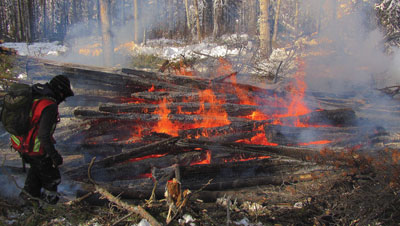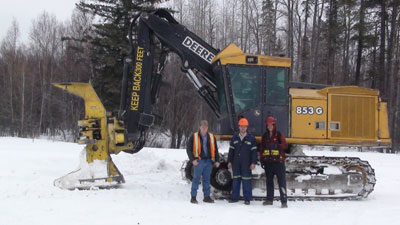
Bioenergy from Beetle-wood
June 8, 2011
By Treena Hein
Economic heartache and headache—that’s what mountain pine beetle (MPB) initially represented for the forest industry in Canada’s West.
Economic heartache and headache—that’s what mountain pine beetle (MPB) initially represented for the forest industry in Canada’s West. But beetle-killed wood also represents an avenue for governments and companies in British Columbia and Alberta to move forward with biomass energy projects. And if conditions change in Alberta, there could be a lot more going on in this arena in the future.
 |
|
| The Great Western Forestry crew has been removing pine-beetle-infested trees in Alberta for five years and chipping some for biomass in the most recent years. Photos: Great Western Forestry
|
While beetle-killed wood bioenergy projects are booming in British Columbia (see the cover story of our January/February 2010 issue; www.canadianbiomassmagazine.ca/content/view/1555/), there are several reasons why there’s only a small amount of activity in Alberta at the present time. For one, the area of MPB infestation is much smaller in Alberta than in British Columbia, a fact everyone hopes will remain true going forward. In addition, bioenergy projects using beetle-killed wood in Alberta have yet to take off because it’s just so much farther to transport pellets or other forms of bioenergy to overseas markets than it is from British Columbia.
“Mountain pine beetle arrived about 10 years ago in the south of Alberta (south of Highway 1) and about 5 years ago in the north,” notes Duncan MacDonnell, a public affairs officer at Alberta’s Ministry of Sustainable Resource Development (SRD). The south also faced infestations in the 1940s and late 1970s. In west-central Alberta (the so-called “wood basket” of the province, where pine is very plentiful), the beetle arrived from the Prince George, British Columbia, area through wind-flight in 2006, and then again in 2009.
 |
|
| Only about one-fifth of the beetle-killed wood is used for biomass. The remainder is burned in situ to kill mountain pine beetle because of transport cost limitations.
|
In this area of the province, 170,000 trees were culled this year and 150,000 last year. “We’ve had a policy of trying to remove every infested tree that’s found,” says MacDonnell. “We’ve asked forest companies to adjust their harvest and instituted single-tree cut-and-burn methods, and we’ve seen a significant decrease in the number of trees now being attacked by the beetle.” The affected acreage is 6 million hectares in Alberta compared to a whopping 14 million hectares in British Columbia. “In BC, they say it’s in decline, which is good,” notes MacDonnell, “but our biggest threat is still more beetles arriving from there by wind-flight.”
SRD has no policy on beetle-killed trees being removed for biomass. “In cases where infested trees are not cut and burned on site, the forest companies are in some cases harvesting them and/or harvesting susceptible trees for various uses,” notes MacDonnell. “It’s up to individual companies how they use or market the wood.”
MacDonnell notes that unlike British Columbia, where large areas are infested, Alberta features “pockets” of infestation. Also, almost all timber in Alberta is allocated under quota Forest Management Agreements or area-based tenures. “There is no situation here where you can say, ‘This whole area is dead, the forest companies don’t want it, it should go for biomass’,” he says. It’s safe to say that no companies are harvesting beetle-killed trees specifically for biomass at present. “Typically, tenure holders would be harvesting beetle-killed volumes to be used in their normal course of production (e.g., lumber, pulp, etc.),” MacDonnell observes. “There likely are side deals that they enter into to sell off unused volumes (or waste streams like hog fuel or bark) to other companies who can use it.”
The MPB tends to attack large, high-quality pine trees, and reforestation is now very much the focus of the province’s Mountain Pine Beetle Action Plan. “But we are encouraging companies to bring biomass energy propositions forward,” MacDonnell says. “The forest industry knows it has to do different things than it has traditionally done in order to move things forward.”
Some bioenergy activity
Canadian Northern Timber (with subsidiaries Atlantic Fibre Resources in the east and Great Western Forestry in the west) was one of the first companies to begin harvesting MPB-killed wood in Alberta five years ago, mostly in the area around Grande Prairie and east of Slave Lake. They use Tigercat and Timberjack equipment for felling and Mobark when chipping, but the vast majority of wood is burned in piles on site.
 |
|
| Globs of sap oozing from beetle entry holes are part of the tree’s natural defence mechanism and a sign that mountain pine beetle has tried to colonize the tree.
|
“The Alberta government began putting out annual beetle-wood salvage tenders, and we bid on those,” says Canadian Northern Timber director of operations Kevin Dudka. “The government also offered MPB survey and control contracts, and we bid on those as well.” Government personnel monitor the completion of the contract to ensure the wood is burned properly or chipped and taken away for burning or further processing.
“We only started chipping the beetle trees during the last three years,” says Dudka. “On average, a fifth of what’s harvested has been chipped.” The chips go to various places: a couple of Canadian Northern Timber hog fuel facilities in Grande Prairie to provide heat for kilns; a few large dairy and hog farms for heat production; and some to the local Canfor facility for making heat and electricity for its mill, but Dudka notes that Canfor mostly uses its own mill residues.
Dudka says that his company tries to ship the chips within a 300-km radius at most. “Transportation is the biggest issue for us in making bioenergy feasible,” he notes. Transportation costs are also the critical factor in whether Canadian Northern Timber builds a pellet production plant in Grande Prairie. Over the last two years, the company has done a lot of research into the question and has determined that the economic picture has to change for a plant to proceed. “It comes down to the market for the pellets,” observes Dudka. “It would be next to impossible to sell them in this area for commercial and residential heating because natural gas is readily available and cheap in comparison.”
 |
|
| Subcontractor Nortech Logging does some harvesting for Great Western Forestry (GWF). Left to right: Owner Willie Krahn, equipment operator Carl Krahn, and GWF supervisor Brian Porter.
|
The company is therefore actively looking for partners to work with to create a plan to ship pellets to British Columbia and/or Asia at a price that’s worthwhile. “Some time ago, we did experimentally transport some chips and had them manufactured into pellets at a facility in Vancouver, then shipped them from the Port of Vancouver to Europe through the Panama Canal,” Dudka explains. “It cost from $64 to $74 per tonne for transportation and $80 per tonne to make the pellets. They won’t pay enough in Europe to cover it.”
To proceed with a pellet plant, transportation costs must become much lower than manufacturing costs. “We have lots of material here, but there needs to be someone who needs a large amount of biomass—not likely in BC—and there needs to be something that happens that would level the energy playing field,” Dudka asserts. “There are lots of incentives for oil and gas companies to do exploration and development, but these don’t exist for forestry. What would change things most effectively is a carbon tax.”
On the east coast, the company’s pellet activities are going strong. In Chandler, Quebec, situated on the Gaspé Peninsula, its Atlantic Fibre Resources subsidiary started construction of a pellet and dimensional lumber plant in May 2011. “It will be completed by September and will be the largest pellet facility on the east coast,” says Dudka. “It will provide 158 full-time jobs, 250,000 tonnes of pellets, and 6 million board feet of lumber that meets European standards.” All lumber and pellets from the plant will be shipped to Denmark, the United Kingdom, Ireland, Finland, and probably Germany as well. Atlantic Fibre Resources is also looking into several other projects, with announcements expected later in the summer.
Print this page